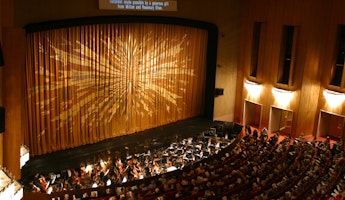Blog
March 6, 2016
An Inspired Puccini Composes “The Humming Chorus”
In the fall of 1900, Giacomo Puccini sat in a London theater, mesmerized by a play entitled Madame Butterfly: A Tragedy of Japan. In the play, “Butterfly,” a Japanese geisha, abandoned by her American naval officer husband, Pinkerton, awaits his return. Puccini immediately grasped the operatic potential in the play’s doomed love story and clash of cultures. Yet one scene in particular—created by the play’s writer, producer and director, David Belasco—inspired him most of all.
Butterfly sits in the center of the stage, holding an overnight vigil, awaiting Pinkerton’s long-overdue return. For several long minutes, she does not speak. Time passes. The sun sets, the stars come out, fade, and then the sun rises again. In the audience, Puccini and those around him truly empathized with Butterfly. The powerful staging eliminated all the distractions, allowing them to focus solely on her emotional plight. It was at that moment that Puccini not only resolved to make Butterfly his next opera, but he also decided to make Butterfly’s vigil an arresting musical moment. Such a long stretch of silence had never been explored in opera and he was determined to see it come to life on the operatic stage.
Puccini’s Madame Butterfly premiered in 1904. In the opera, Butterfly’s vigil became the “Coro a bocca chiusa” or “The Humming Chorus.” This is a moment of calm, when Butterfly peacefully (and silently) waits for Pinkerton. It’s one of the most compelling moments in the opera, when the audience sees Butterfly’s optimism for the last time, before it is utterly shattered by the arrival of Pinkerton and his new wife. The emotional effect Belasco achieved through silence, Puccini achieves through the exquisitely beautiful melody sung by the wordless, offstage chorus.
It is one thing to hear the music of “The Humming Chorus,” but to understand the full emotional weight of the piece, it must be seen live in its proper context. Our production of Madame Butterfly takes an arresting approach to the iconic scene. Butterfly’s plight is grasped through the loyalty of her servant, Suzuki. As Butterfly and her son calmly wait for Pinkerton, backs turned from the audience, Suzuki has her moment and it becomes clear that she’s skeptical about whether Pinkerton will ever return, but struggles to support Butterfly nonetheless. It is a beautiful moment in a production infused with similarly important directorial details that Puccini would have found inspiring.








/03-cosi/_dsc0996_pr.jpg?format=auto&fit=crop&w=345&h=200&auto=format)













